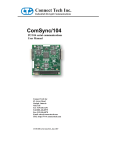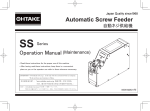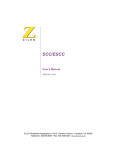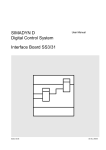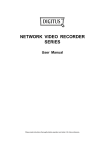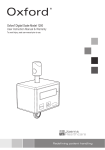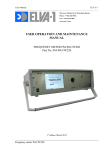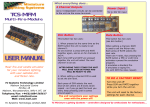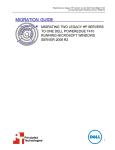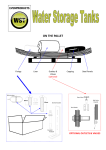Download Chapter 3: SCC/ESCC Ancillary Support Circuitry
Transcript
USER’S MANUAL 3 CHAPTER 3 SCC/ESCC ANCILLARY SUPPORT CIRCUITRY 3.1 INTRODUCTION The serial channels of the SCC are supported by ancillary circuitry for generating clocks and performing data encoding and decoding. This chapter presents a description of these functional blocks. Note to SCC Users: The ancillary circuitry in the ESCC is the same as in the SCC with the following noted changes. The DPLL (Dual Phased-Locked Loop) output, when used as the transmit clock source, has been changed to be free of jitter. Consequently, this only affects the use of the DPLL as the transmit clock source (it is typically used for the receive clock source), this has no effect on using the DPLL as the receive clock source. Note to ESCC/CMOS Users: The maximum input frequency to the DPLL has been specified as two times the PCLK frequency (Spec #16b TxRX(DPLL)). There are no changes to the baud rate generators from the NMOS to the CMOS/ESCC. 3.2 BAUD RATE GENERATOR The Baud Rate Generator (BRG) is essential for asynchronous communications. Each channel in the SCC contains a programmable baud rate generator. Each generator consists of two 8-bit, time-constant registers forming a16-bit time constant, a 16-bit down counter, and a flip-flop on the output so that it outputs a square wave. On start-up, the flip-flop on the output is set High, so that it starts in a known state, the value in the time-constant register is loaded into the counter, and the counter begins counting down. When a count of zero is reached, the output of the baud rate generator toggles, the value in the time-constant register is loaded into the counter, and the process starts over. The programmed time constant is read from RR12 and RR13. A block diagram of the baud rate generator is shown in Figure 3-1. WR12 WR 13 Zero Count 16-Bit Counter /RTxC Pin PCLK Pin Baud Rate Generator Clock (Takes One More Clock to Load Time Constant Value to Counter ÷2 Output ÷Clock Mode (Gives one Transition Each Time the Counter Counts to Zero) (May Provide Higher Resolution to Sample Data) Desired Baud (Asynchronous Mode) Figure 3-1. Baud Rate Generator 3-1 SCC™/ESCC™ User’s Manual SCC/ESCC Ancillary Support Circuitry 3.2 BAUD RATE GENERATOR (Continued) The time-constant can be changed at any time, but the new value does not take effect until the next load of the counter (i.e., after zero count is reached). No attempt is made to synchronize the loading of a new time-constant with the clock used to drive the generator. When the time-constant is to be changed, the generator should be stopped first by writing WR14 D0=0. After loading the new time constant, the BRG can be started again. This ensures the loading of a correct time constant, but loading does not take place until zero count or a reset occurs. If neither the transmit clock nor the receive clock are programmed to come from the /TRxC pin, the output of the baud rate generator may be made available for external use on the /TRxC pin. Note: This feature is very useful for diagnostic purposes. By programming the output of the baud rate generator as output on the /TRxC pin, the BRG is source and time tested, and the programmed time constant verified. The clock source for the baud rate generator is selected by bit D1 of WR14. When this bit is set to 0, the BRG uses the signal on the /RTxC pin as its clock, independent of whether the /RTxC pin is a simple input or part of the crystal oscillator circuit. When this bit is set to 1, the BRG is clocked by the PCLK. To avoid metastable problems in the counter, this bit should be changed only while the baud rate generator is disabled, since arbitrarily narrow pulses can be generated at the output of the multiplexer when it changes status. The BRG is enabled while bit D0 of WR14 is set to 1. It is disabled while WR14 D0=0 and after a hardware reset (but not a software reset). To prevent metastable problems when the baud rate generator is first enabled, the enable bit is synchronized to the baud rate generator clock. This introduces an additional delay when the baud rate generator is first enabled (Figure 3-2). The baud rate generator is disabled immediately when bit D0 of WR14 is set to 0, because the delay is only necessary on start-up. The baud rate generator is enabled and disabled on the fly, but this delay on start-up must be taken into consideration. Figure 3-2. Baud Rate Generator Start Up 3-2 SCC™/ESCC™ User’s Manual SCC/ESCC Ancillary Support Circuitry The formulas relating the baud rate to the time-constant and vice versa are shown below. Time Constant = Baud Rate = Clock Frequency -2 2 x (Clock Mode) x (Baud Rate) Clock Frequency 2 x (Clock Mode) x (Time Constant+ 2) In these formulas, the BRG clock frequency (PCLK or /RTxC) is in Hertz, the desired baud rate in bits/sec, Clock Mode is 1 in sync modes, 1, 16, 32 or 64 in async mode and the time constant is dimensionless. The example in Table 3-1 assumes a 2.4576 MHz clock (from /RTxC) factor of 16 and shows the time constant for a number of popular baud rates. For example: 6 TC = 106 2.4576 x 10 (2 x 16) x 150 . -2 = 510 Table 3-1. Baud Rates for 2.4576 MHz Clock and 16x Clock Factor Baud Rate 38400 19200 9600 4800 2400 1200 600 300 150 3 Time Constant Decimal 0 2 6 14 30 62 126 254 510 Hex 0000 0002 0006 000E 001E 003E 007E 00FE 01FE Other commonly used clock frequencies include 3.6846, 4.6080, 4.91520, 6.144, 7.3728, 9.216, 9.8304, 12.288, 14.7456, 19.6608 (units in MHz). Initializing the BRG is done in three steps. First, the timeconstant is determined and loaded into WR12 and WR13. Next, the processor must select the clock source for the BRG by setting bit D1 of WR14. Finally, the BRG is enabled by setting bit D0 of WR14 to 1. Note: The first write to WR14 is not necessary after a hardware reset if the clock source is the /RTxC pin. This is because a hardware reset automatically selects the /RTxC pin as the BRG clock source. 3-3 SCC™/ESCC™ User’s Manual SCC/ESCC Ancillary Support Circuitry 3.3 DATA ENCODING/DECODING Data encoding is utilized to allow the transmission of clock and data information over the same medium. This saves the need to transmit clock and data over separate medium as would normally be required for synchronous data. The SCC provides four different data encoding methods, selected by bits D6 and D5 in WR10. An example of these DATA 1 1 0 0 four encoding methods is shown in Figure 3-3. Any encoding method is used in any X1 mode in the SCC, asynchronous or synchronous. The data encoding selected is active even though the transmitter or receiver is idling or disabled. 1 0 High = 1 Low = 0 NRZ No Change = 1 Change = 0 NRZI Bit Center Transition: Transition = 1 No Transition = 0 FM1 (Biphase Mark) FM0 (Biphase Space) No Transition = 1 Transition = 0 MANCHESTER High → Low = 1 Low → High = 0 Figure 3-3. Data Encoding Methods 3-4 Bit Cell Level: SCC™/ESCC™ User’s Manual SCC/ESCC Ancillary Support Circuitry NRZ (Non-Return to Zero). In NRZ, encoding a 1 is represented by a High level and a 0 is represented by a Low level. In this encoding method, only a minimal amount of clocking information is available in the data stream in the form of transitions on bit-cell boundaries. In an arbitrary data pattern, this may not be sufficient to generate a clock for the data from the data itself. FM1 (Bi-phase Mark). In FM1 encoding, also known as biphase mark, a transition is present on every bit cell boundary, and an additional transition may be present in the middle of the bit cell. In FM1, a 0 is sent as no transition in the center of the bit cell and a 1 is sent as a transition in the center of the bit cell. FM1 encoded data contains sufficient information to recover a clock from the data. NRZI (Non-Return to Zero Inverted). In NRZI, encoding a 1 is represented by no change in the level and a 0 is represented by a change in the level. As in NRZ, only a minimal amount of clocking information is available in the data stream, in the form of transitions on bit cell boundaries. In an arbitrary data pattern this may not be sufficient to generate a clock for the data from the data itself. In the case of SDLC, where the number of consecutive 1s in the data stream is limited, a minimum number of transitions to generate a clock are guaranteed. FM0 (Bi-phase Space). In FM0 encoding, also known as bi-phase space, a transition is present on every bit cell boundary and an additional transition may be present in the middle of the bit cell. In FM0, a 1 is sent as no transition in the center of the bit cell and a 0 is sent as a transition in the center of the bit cell. FM0 encoded data contains sufficient information to recover a clock from the data. ESCC: TxD Pin Forced High in SDLC feature. When the ESCC is programmed for SDLC mode with NRZI data encoding and mark idle (WR10 D6=0, D5=1, D3=1), the TxD pin is automatically forced high when the transmitter goes to the mark idle state. There are several different ways for the transmitter to go into the idle state. In each of the following cases the TxD pin is forced high when the mark idle condition is reached: data, CRC, flag and idle; data, flag and idle; data, abort (on underrun) and idle; data, abort (command) and idle; idle flag and command to idle mark. The Force High feature is disabled when the mark idle bit is reset. The TxD pin is forced High on the falling edge of the TxC cycle after the falling edge of the last bit of the closing flag. Using SDLC Loop mode is independent of this feature. Manchester (Bi-phase Level). Manchester (bi-phase level) encoding always produces a transition at the center of the bit cell. If the transition is Low to High, the bit is 0. If the transition is High to Low, the bit is 1. Encoding of Manchester format requires an external circuit consisting of a ‘D’ flip-flop and four gates (Figure 3-4). The SCC is used to decode Manchester data by using the DPLL in the FM mode and programming the receiver for NRZ data (See Section 3.1.3). Data Encoding Initialization. The data encoding method is selected in the initialization procedure before the transmitter and receiver are enabled, but no other restrictions apply. Note that in NRZ and NRZI, the receiver samples the data only on one edge, as shown in Figure 3-3. However, in FM1 and FM0, the receiver samples the data on both edges. Also, as shown in Figure 3-3, the transmitter defines bit cell boundaries by one edge in all cases and uses the other edge in FM1 and FM0 to create the mid-bit transition. This feature is used in combination with the automatic SDLC opening flag transmission feature, WR7' D0=1, to assure that data packets are properly formatted. Therefore, when these features are used together, it is not necessary for the CPU to issue any commands when using the force idle mode in combination with NRZI data encoding. If WR7' D0 is reset, like the SCC, it is necessary to reset the mark idle bit (WR10 D2) to enable flag transmission before an SDLC packet is transmitted. 3-5 3 SCC™/ESCC™ User’s Manual SCC/ESCC Ancillary Support Circuitry 3.3 DATA ENCODING/DECODING (Continued) NRZ 3 b a 1 4 2 Transmit Clock Transmit Clock NRZ 1 2 3 4 5 Figure 3-4. Manchester Encoding Circuit 3-6 5 Manchester SCC™/ESCC™ User’s Manual SCC/ESCC Ancillary Support Circuitry 3.4 DPLL DIGITAL PHASE-LOCKED LOOP Each channel of the SCC contains a digital phase-locked loop that can be used to recover clock information from a data stream with NRZI, FM, NRZ, or Manchester encoding. The DPLL is driven by a clock nominally at 32 (NRZI) or 16 (FM) times the data rate. The DPLL uses this clock, along with the data stream, to construct a receive clock for the data. This clock can then be used as the SCC receive clock, the transmit clock, or both. RxD Edge Detector Figure 3-5 shows a block diagram of the digital phaselocked loop. It consists of a 5-bit counter, an edge detector, and a pair of output decoders. The clock for the DPLL comes from the output of a two-input multiplexer, and the two outputs go to the transmitter and receive clock multiplexers. The DPLL is controlled by seven commands encoded in WR14 bits D7, D6 and D5. Count Modifier Decode Receive Clock 5-Bit Counter Decode Transmit Clock Figure 3-5. Digital Phase-Locked Loop The clock source for the DPLL is selected issuing one of the two commands in WR14, that is: WR14 (7-5) = 100 selects the BRG WR14 (7-5) = 101 selects the /RTxC pin The first command selects the baud rate generator as the clock source. The other command selects the /RTxC pin as the clock source, independent of whether the /RTxC pin is a simple input or part of the crystal oscillator circuit. Initialization of the DPLL is done at any time during the initialization sequence, but should be done after the clock modes have been selected in WR11, and before the receiver and transmitter are enabled. When initializing the DPLL, the clock source should be selected first, followed by the selection of the operating mode. To avoid metastable problems in the counter, the clock source selection is made only while DPLL is disabled, since arbitrarily narrow pulses are generated at the output of the multiplexer when it changes status. The DPLL is programmed to operate in one of two modes, as selected by commands in WR14. As in the case of the clock source selection, the mode of operation is only changed while the DPLL is disabled to prevent unpredictable results. In the NRZI mode, the DPLL clock must be 32 times the data rate. In this mode, the transmit and receive clock outputs of the DPLL are identical, and the clocks are phased so that the receiver samples the data in the middle of the bit cell. In NRZI mode, the DPLL does not require a transition in every bit cell, so this mode is useful for recovering the clocking information from NRZ and NRZI data streams. In the FM mode, the DPLL clock must be 16 times the data rate. In this mode, the transmit clock output of the DPLL lags the receive clock outputs by 90 degrees to make the transmit and receive bit cell boundaries the same, because the receiver must sample FM data at one-quarter and three-quarters bit time. The DPLL is enabled by issuing the Enter Search Mode command in WR14; that is WR14 (7-5) = 001. The Enter Search Mode command unlocks the counter, which is held while the DPLL is disabled, and enables the edge detector. If the DPLL is already enabled when this command is issued, the DPLL also enters Search Mode. WR14 (7-5) = 111 selects NRZI mode WR14 (7-5) = 110 selects FM mode Note: A channel or hardware reset disables the DPLL, selects the /RTxC pin as the clock source for the DPLL, and places it in the NRZI mode. 3-7 3 SCC™/ESCC™ User’s Manual SCC/ESCC Ancillary Support Circuitry 3.4 DPLL DIGITAL PHASE-LOCKED LOOP (Continued) 3.4.1 DPLL Operation in the NRZI Mode To operate in NRZI mode, the DPLL must be supplied with a clock that is 32 times the data rate. The DPLL uses this clock, along with the receive data, to construct receive and transmit clock outputs that are phased to properly receive and transmit data. To do this, the DPLL divides each bit cell into four regions, and makes an adjustment to the count cycle of the 5-bit counter dependent upon the region a transition on the receive data input occurred (Figure 3-6). Ordinarily, a bit-cell boundary occurs between count 15 and count 16, and the DPLL output causes the data to be sampled in the middle of the bit cell. However, four different situations can occur: If the bit-cell boundary (from space to mark) occurs anywhere during the second half of count 15 or the first half of count 16, the DPLL allows the transition without making a correction to its count cycle. If the bit cell boundary (from space to mark) occurs between the middle of count 16 and count 31, the DPLL is sampling the data too early in the bit cell. In response to this, the DPLL extends its count by one during the next 0 to 31 counting cycle, which effectively moves the edge of the clock that samples the receive data closer to the center of the bit cell. If the transition occurs between count 0 and the middle of count 15, the output of the DPLL is sampling the data too late in the bit cell. To correct this, the DPLL shortens its count by one during the next 0 to 31 counting cycle, which effectively moves the edge of the clock that samples the receive data closer to the center of the bit cell. If the DPLL does not see any transition during a counting cycle, no adjustment is made in the following counting cycle. If an adjustment to the counting cycle is necessary, the DPLL modifies count 5, either deleting it or doubling it. Thus, only the Low time of the DPLL output is lengthened or shortened. Bit Cell Count 16 17 18 19 20 21 22 23 24 25 26 27 28 29 30 31 0 Correction 1 2 Add One Count 3 4 5 6 7 8 9 10 11 12 13 14 15 Subtract One Count No Change No Change DPLL Out Figure 3-6. DPLL in NRZI Mode While the DPLL is in search mode, the counter remains at count 16, where the DPLL outputs are both High. The missing clock latches in the DPLL, which may be accessed 3-8 in RR10, are not used in NRZI mode. An example of the DPLL in operation is shown in Figure 3-7. SCC™/ESCC™ User’s Manual SCC/ESCC Ancillary Support Circuitry Receive Data 3 DPLL Output Correction Windows +1 Count Length 32 -1 +1 32 -1 +1 32 -1 +1 31 -1 31 +1 -1 +1 -1 31 +1 -1 33 +1 33 -1 +1 33 Figure 3-7. DPLL Operating Example (NRZI Mode) 3.4.2 DPLL Operation in the FM Modes To operate in FM mode, the DPLL must be supplied with a clock that is 16 times the data rate. The DPLL uses this clock, along with the receive data, to construct, receive, and transmit clock outputs that are phased to receive and transmit data properly. In FM mode, the counter in the DPLL counts from 0 to 31, but now each cycle corresponds to 2-bit cells. To make adjustments to remain in phase with the receive data, the DPLL divides a pair of bit cells into five regions, making the adjustment to the counter dependent upon which region the transition on the receive data input occurred (Figure 3-8). Bit Cell Count Correction 16 17 18 19 20 21 22 23 24 25 26 27 28 29 30 31 0 +1 1 2 3 4 5 Ignored No Change 6 7 8 9 10 11 12 13 14 15 +1 No Change RX DPLL Out TX DPLL Out Figure 3-8. DPLL Operation in the FM Mode 3-9 SCC™/ESCC™ User’s Manual SCC/ESCC Ancillary Support Circuitry 3.4 DPLL DIGITAL PHASE-LOCKED LOOP (Continued) In FM mode, the transmit clock and receive clock outputs from the DPLL are not in phase. This is necessary to make the transmit and receive bit cell boundaries coincide, since the receive clock must sample the data one-fourth and three-fourths of the way through the bit cell. Ordinarily, a bit cell boundary occurs between count 15 or count 16, and the DPLL receive output causes the data to be sampled at one-fourth and three-fourths of the way through the bit cell. However, four variations can occur: If the bit-cell boundary (from space to mark) occurs anywhere during the second half of count 15 or the first half of count 16, the DPLL allows the transition without making a correction to its count cycle. If the bit-cell boundary (from space to mark) occurs between the middle of count 16 and the middle of count 19, the DPLL is sampling the data too early in the bit cell. In response to this, the DPLL extends its count by one during the next 0 to 31 counting cycle, which effectively moves the receive clock edges closer to where they should be. Any transitions occurring between the middle of count 19 in one cycle and the middle of count 12 during the next cycle are ignored by the DPLL. This guarantees that any data transitions in the bit cells do not cause an adjustment to the counting cycle. If no transition occurs between the middle of count 12 and the middle of count 19, the DPLL is probably not locked onto the data properly. When the DPLL misses an edge, the One Clock Missing bit is RR10, it is set to 1 and latched. It will hold this value until a Reset Missing Clock command is issued in WR14, or until the DPLL is disabled or programmed to enter the Search mode. Upon missing this one edge, the DPLL takes no other action and does not modify its count during the next counting cycle. If the DPLL does not see an edge between the middle of count 12 and the middle of count 19 in two successive 0 to 31 count cycles, a line error condition is assumed. If this occurs, the Two Clocks Missing bit in RR10 is set to 1 and latched. At the same time, the DPLL enters the Search mode. The DPLL makes the decision to enter the Search mode during count 2, where both the receive clock and transmit clock outputs are Low. This prevents any glitches on the clock outputs when the Search mode is entered. While in the Search mode, no clock outputs are provided by the DPLL. The Two Clocks Missing bit in RR10 is latched until a Reset Missing Clock command is issued in WR14, or until the DPLL is disabled or programmed to enter the Search mode. 3-10 While the DPLL is disabled, the transmit clock output of the DPLL may be toggled by alternately selecting FM and NRZI mode in the DPLL. The same is true of the receive clock. While the DPLL is in the Search mode, the counter remains at count 16 where the receive output is Low and the transmit output is Low. This fact is used to provide a transmit clock under software control since the DPLL is in the Search mode while it is disabled. As in NRZI mode, if an adjustment to the counting cycle is necessary, the DPLL modifies count 5, either deleting it or doubling it. If no adjustment is necessary, the count sequence proceeds normally. When the DPLL is programmed to enter Search mode, only clock transitions should exist on the receive data pin. If this is not the case, the DPLL may attempt to lock on to the data transitions. If the DPLL does lock on to the data transitions, then the Missing Clock condition will inevitably occur because data transitions are not guaranteed every bit cell. To lock in the DPLL properly, FM0 encoding requires continuous 1s received when leaving the Search mode. In FM1 encoding, continuous 0s are required; with Manchester encoded data this means alternating 1s and 0s. With all three of these data encoding methods there is always at least one transition in every bit cell, and in FM mode the DPLL is designed to expect this transition. 3.4.3 DPLL Operation in the Manchester Mode The SCC can be used to decode Manchester data by using the DPLL in the FM mode and programming the receiver for NRZ data. Manchester encoded data contains a transition at the center of every bit cell; it is the direction of this transition that distinguishes a 1 from a 0. Hence, for Manchester data, the DPLL should be in FM mode (WR14 command D7=1, D6=1, D5=0), but the receiver should be set up to accept NRZ data (WR10 D6=0, D5=0). 3.4.4 Transmit Clock Counter (ESCC only) The ESCC includes a Transmit Clock Counter which parallels the DPLL. This counter provides a jitter-free clock source to the transmitter by dividing the DPLL clock source by the appropriate value for the programmed data encoding format as shown in Figure 3-9. Therefore, in FM mode (FM0 or FM1), the counter output is the input frequency divided by 16. In NRZI mode, the counter frequency is the input divided by 32. The counter output replaces the DPLL transmit clock output, available as the transmit clock source. This has no effect on the use of the DPLL as the receive clock source. SCC™/ESCC™ User’s Manual SCC/ESCC Ancillary Support Circuitry The output of the transmit clock derived from this counter is available to the /TRxC pin when the DPLL output is selected as the transmit clock source. Care must be taken using ESCC in SDLC Loop mode with the DPLL. The SDLC Loop mode requires synchronized Tx and Rx DPLL CLK Input clocks, but the ESCC’s DPLL might be off-sync because of this Transmit Clock Counter. In SDLC Loop, one should instead echo the signal of the RxDPLL out to clock the receiver and transmitter to achieve synchronization. This can be programmed via bits D1-D0 in WR11. DPLL DPLL Output to Receiver DPLL Counter DPLL Output to Transmitter Input Divided by 16 (FM0 or FM1) Input Divided by 32 for NRZI Figure 3-9. DPLL Transmit Clock Counter Output (ESCC only) 3.5 CLOCK SELECTION The SCC can select several clock sources for internal and external use. Write Register 11 is the Clock Mode Control register for both the receive and transmit clocks. It determines the type of signal on the /SYNC and /RTxC pins and the direction of the /TRxC pin. The SCC is programmed to select one of several sources to provide the transmit and receive clocks. The source of the receive clock is controlled by bits D6 and D5 of WR11. The receive clock may be programmed to come from the /RTxC pin, the /TRxC pin, the output of the baud rate generator, or the receive output of the DPLL. The source of the transmit clock is controlled by bits D4 and D3 of WR11. The transmit clock may be programmed to come from the /RTxC pin, the /TRxC pin, the output of the baud rate generator, or the transmit output of the DPLL. Ordinarily, the /TRxC pin is an input, but it can become an output if this pin has not been selected as the source for the transmitter or the receiver, and bit D2 of WR11 is set to 1. The selection of the signal provided on the /TRxC output pin is controlled by bits D1 and D0 of WR11. The /TRxC pin is programmed to provide the output of the crystal oscillator, the output of the baud rate generator, the receive output of the DPLL or the actual transmit clock. If the output of the crystal oscillator is selected, but the crystal oscillator has not been enabled, the /TRxC pin is driven High. The option of placing the transmit clock signal on the /TRxC pin when it is an output allows access to the transmit output of the DPLL. to the multiplexer section, as well as the various signal inversions that occur in the paths to the outputs. Selection of the clocking options may be done anywhere in the initialization sequence, but the final values must be selected before the receiver, transmitter, baud rate generator, or DPLL are enabled to prevent problems from arbitrarily narrow clock signals out of the multiplexers. The same is true of the crystal oscillator, in that the output should be allowed to stabilize before it is used as a clock source. Also shown are the edges used by the receiver, transmitter, baud rate generator and DPLL to sample or send data or otherwise change state. For example, the receiver samples data on the falling edge, but since there is an inversion in the clock path between the /RTxC pin and the receiver, a rising edge of the /RTxC pin samples the data for the receiver. The following shows three examples for selecting different clocking options. Figure 3-11 shows the clock set up for asynchronous transmission, 16x clock mode using the onchip oscillator with an external crystal. This example uses the oscillator as the input to the baud rate generator, although it can be used directly as the transmit or receive clock source. The registers involved are WR11 through WR14 and the figure shows the programming in these registers. An example of asynchronous communication where a 1x clock is obtained from an external MODEM is shown in Figure 3-12. The data encoding is NRZ. Note that: 1. The BRG is not used under this configuration. Figure 3-10 shows a simplified schematic diagram of the circuitry used in the clock multiplexing. It shows the inputs 3-11 3 SCC™/ESCC™ User’s Manual SCC/ESCC Ancillary Support Circuitry 3.5 CLOCK SELECTION (Continued) 2. The x1 mode in Asynchronous mode is a combination of both synchronous and asynchronous transmission. The data is clocked by a common timing base, but characters are still framed with Start and Stop bits. Because the receiver waits for one clock period after detecting the first High-to-Low transition before beginning to assemble characters, the data and clock is synchronized externally. The x1 mode is the only mode in which a data encoding method other than NRZ is used. OSC RX /SYNC Receiver OSC /RTxC TX /TRxC Transmitter Echo DPLL Baud Rate Generator Out Echo DPLL Tx DPLL Out BRG Rx DPLL Out Baud Rate Generator PCLK Figure 3-10. Clock Multiplexer 3-12 SCC™/ESCC™ User’s Manual SCC/ESCC Ancillary Support Circuitry External Crystal 3 /SYNC Pin B R G 16x Output TxC RxC /RTxC Pin /TRxC Pin SCC Figure 3-11. Async Clock Setup Using an External Crystal WR11 D7 1 WR14 D0 1 0 1 0 1 1 D1 0 0 /TRxC OUT = BRG Output BRG Clock Source = /RTXC or XTAL OSCILLATOR /TRxC Pin = Output Pin Tx Clock = BRG Output Rx Clock = BRG Output Using External Crystal NRZ Data SYNC Modem TxC 1x RxD Pin /RTxC Pin RxC SCC Figure 3-12. Clock Source Selection 3-13 SCC™/ESCC™ User’s Manual SCC/ESCC Ancillary Support Circuitry 3.6 CRYSTAL OSCILLATOR (Continued) Figure 3-13 shows the use of the DPLL to derive a 1x clock from the data. In this example: The DPLL clock output = RxC (receiver clock) WR11. Set FM mode WR14. The DPLL clock input = BRG output (x16 the data rate) WR14. External Crystal Set FM mode WR10. /SYNC Pin B R G /RTxC Pin RxD Pin 16x Data Rate D P L L RxC TxC RxD Figure 3-13. Synchronous Transmission, 1x Clock Rate, FM Data Encoding, using DPLL 3.6 CRYSTAL OSCILLATOR Each channel contains a high gain oscillator amplifier for use with an external crystal circuit. The amplifier is available between the /RTxC pin (crystal input) and the /SYNC pin (crystal output) for each channel. The oscillator amplifier is enabled by writing WR11 D7=1. While the crystal oscillator is enabled, anything that has selected the /RTxC pin as its clock source automatically connects to the output of the crystal oscillator. Note: The output of the oscillator amplifier can be programmed to output on the /TRxC pin, which is particularly valuable for diagnostic purposes. Because amplifier characteristics can be affected by the impedance of measurement equipment applied directly to the crystal circuit, using the /TRxC pin allows the oscillation to be tested without affecting the circuit. 3-14 Of course, since the oscillator uses the /RTxC and /SYNC pins, this precludes the use of these pins for other functions. In synchronous modes, no sync pulse is output, and the External Sync mode cannot be selected. In asynchronous modes, the state of the Sync/Hunt bit in RR0 is no longer controlled by the /SYNC pin. Instead, the Sync/Hunt bit is forced to 0. The crystal oscillator requires some finite time to stabilize and must be allowed to stabilize before it is used as a clock source. This stabilization time is dependent on the external circuit impedance and 20 ms is a suggested minimum. The External Crystal should operate in parallel resonance. For further details on designing with the crystal, refer to Appendix A, “On-Chip Oscillator Design”.














